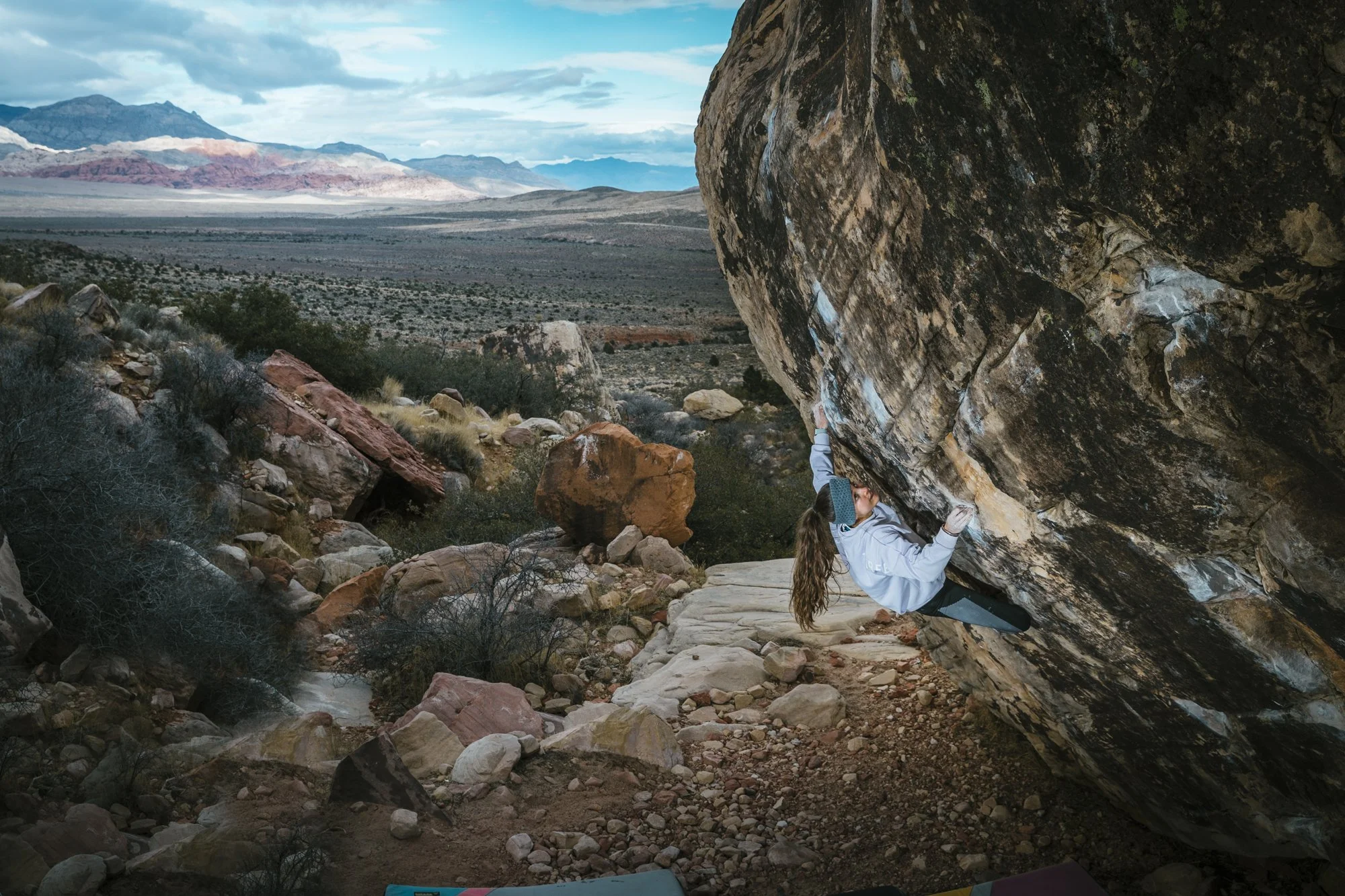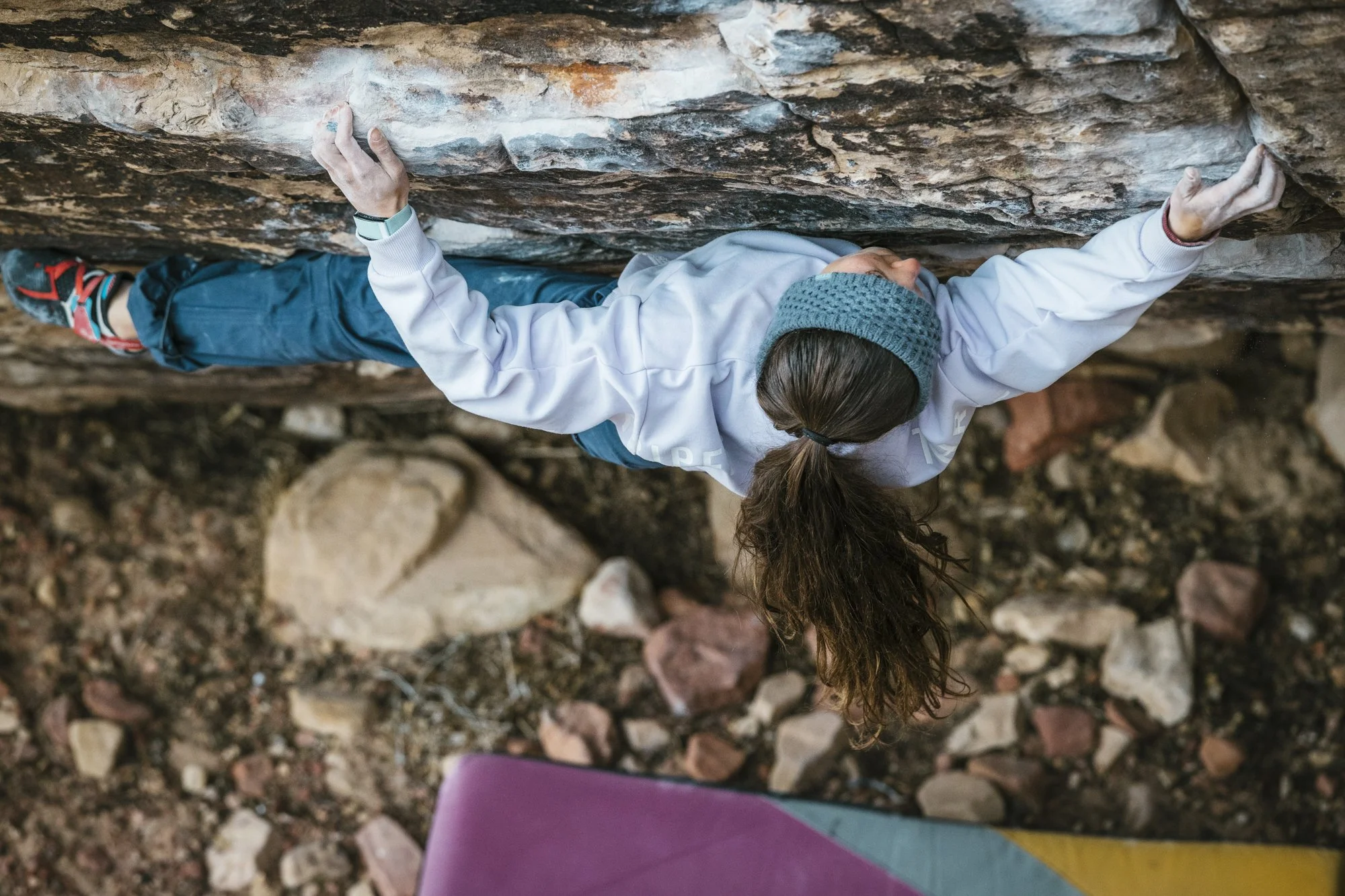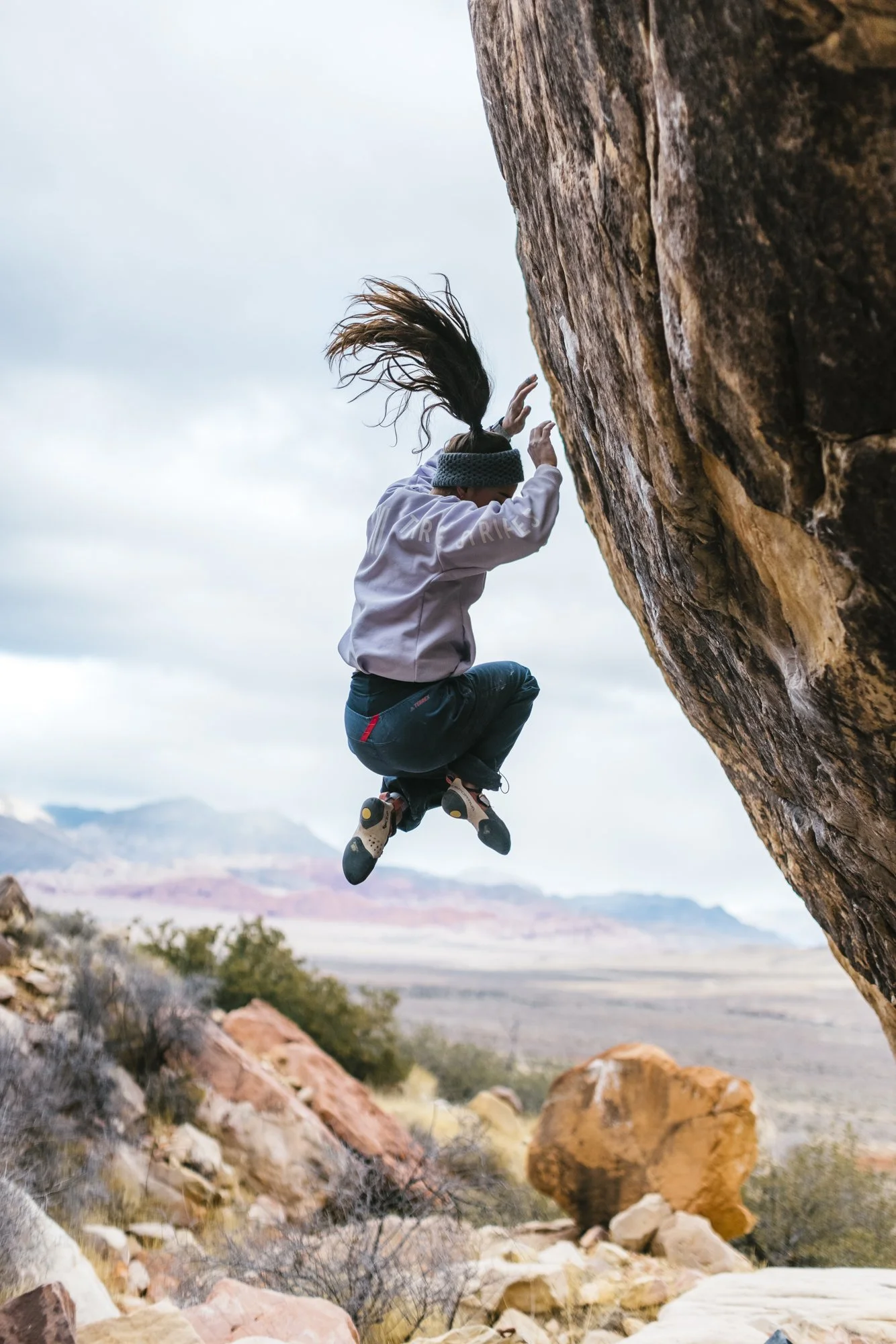A Profile on Robert Hicks Bates Award Winner Brooke Raboutou
By Sierra McGivney
Photos by Jess Glassberg/LouderThan11
Brooke Raboutou had booked her flight home. She had one final session to send Excalibur 9b+ (5.15c)—an18-move, 40-degree crimpy sport climb near Acro, Italy—before that flight. She felt good about it. She needed the time pressure, similar to a competition. In her mind, two things were true: She might have to walk away from Excalibur for the season, and she could send it during that final session.
On Saturday, she began her day like every other, with yoga and meditation in her Airbnb, breakfast, and a warm up at her friends’ climbing wall. It was the warmest day she had had in Italy, a good sign, since she had previously numbed out on the climb. On her first try on the route that day, she fell on the last move. We’re getting into it, that felt good,Raboutou thought. She fell off the third move on her second try, which hadn’t happened in a while. She wasn’t frustrated; this was part of the process.
“I felt like I mentally was in a place where I was able to try harder than I had before, and had more of a margin than maybe a month ago, from just training on the climb,” said Raboutou.
She rested for 30 seconds and then hopped back on, trying harder than ever. Not every move was perfect, but this time, she stuck the final move from the ground, and time stopped as she clipped the chains.
She topped out the feature, making the moment even more special. Every fall, every moment of doubt, all the ripped skin and sore muscles, the days filled with cold weather, were background noise to this moment, this historic climb—Raboutou believing fully in her abilities and achieving something only a few climbers have.
With her ascent of Excalibur, Brooke Raboutou became the first woman in the world to climb 5.15c.
This cutting-edge success didn’t come out of nowhere. Raboutou has been crushing boulders for the last few years while balancing the Climbing World Cup, the Olympics, and college.
In May 2020, she sent Muscle Car (V14), her first of the grade. Her summer bouldering season in Rocky Mountain National Park saw solid sends with The Automator (V13), The Shining (V12/V13), The Wheel of Chaos (V13), Doppelgänger Poltergeist (V13),and Jade (V14). Raboutou also attended the 2020 Tokyo Summer Olympics, earning fifth in the overall combined event (speed, lead, and bouldering).
After the Tokyo Olympics, she felt very low and lost for a while. It was a pivotal time—she was a sophomore in college and still figuring out what she wanted to do with her life. She didn’t expect to feel the post-Olympics depression that a lot of athletes deal with. Raboutou worked with a sports psychologist and a therapist to help her process her emotions and goals in this heightened context of elite competition. She started to put her well-being above climbing and training. She is still constantly working on shifting that paradigm.
Photo by Jess Glassberg/LouderThan11.
It’s no surprise that in 2021 and 2022, Raboutou sent a handful of V13s and V14s, most of them documented on her Instagram and Mellow Climbing’s YouTube: Euro Trash (V12/8a+) and Euro Roof Low Low (V13/8b) in Little Cottonwood Canyon, Utah; Trieste (V14) in Red Rocks, Nevada; Heritage (V13), La Proue (V13) and Lur (V14) in Switzerland, snagging the FFA for La Proue; and Evil Backwards (V13) in the Mt. Blue Sky area, Colorado.
By the end of 2022, only three women had climbed V15, and none had climbed V16. But the dream was there.
Early in 2023, Raboutou graduated from the University of San Diego with a degree in marketing—something she was cautioned against since she had a full-time professional climbing career. She also took classes in psychology and was interested in how mental health and climbing interact. Balancing learning and climbing was important to her.
“I love climbing so much, but I’ve always believed it cannot be my everything,” said Raboutou.
In October of 2023, Raboutou sent Box Therapy (V15/V16) in Rocky Mountain National Park, and she promptly downgraded it from V16 to V15. Her brother, Shawn Raboutou, an elite boulderer who has climbed V17, sent the boulder that same day. In an Instagram post, she wrote, “I first touched this boulder in September 2022 and have not stopped dreaming about it since that day. It took me a whole year to get back on it, but in a few sessions, I was able to stand atop one of the most beautiful climbs I’ve ever done.”
The following year, she turned her sights toward the 2024 Paris Olympics. With only two spots for women on the bouldering and lead USA climbing Olympic team, the pressure was on. Natalia Grossman secured the first spot during the Pan American Games in Chile. In June 2024, Raboutou secured her place on the team in the Budapest Olympic Qualifiers.
Coming back to the Olympics the second time, she felt more grown up. She knew what to expect and had built a support team since Tokyo that would help her thrive under the unique pressure of competing in the Olympics.
Photo by Jess Glassberg/LouderThan11.
For most of the competition, Raboutou was neck and neck with Janja Garnbret, a Slovenian climber widely considered one of the best competition climbers of all time, who had taken home gold in the Tokyo Olympics. After a stellar showing during the boulder- ing finals, Raboutou launched into the final lead competition knowing she would medal in some form for the combined event. Ultimately, Garnbret eked out more points, taking home gold once again. Once Garnbret lowered, climbers and non-climbers alike watched as the two hugged, smiling—sharing an emo- tional moment. Raboutou took home silver in the combined bouldering and lead category, becoming the first American woman to win an Olympic medal in climbing.
With such a massive win behind her, Raboutou visited Europe in November and December 2024 to find a project that would push her limits. She was following her brother around, and he encouraged her to hop on Excalibur.
Cristian Dorigatti and Morris Fontanari originally bolted Excalibur. The route is named for a sculpture of a sword in an anvil near the base of the climb. Shortly after bolting the route, the pair invited Stefano Ghisolfi to try it. He made the first ascent of Excalibur in 2023. Will Bosi made the second ascent on February 3, 2025. The route had a definite mystique.
Raboutou knew she wanted to climb the route the first time she touched it. The climb was in her style while still pushing her—something she constantly strives for. With 18 moves, the climb is almost like a long boulder. She was progressing fast; by the fourth or fifth session on Excalibur, Raboutou was falling on the last move.
The crux for most other climbers is a notorious two-finger pocket undercling combined with a high heel hook in a tight box. Because of her flexibility, this move was one of the easier moves for Raboutou. Still, the subsequent and final move required her to launch out of this position and reach farther than most other climbers because of her height. The sequence was frustrating, but she would define it as a love-hate relationship.
However, variables like skin, weather, and a minor shoulder injury slowed her progression. Raboutou decided to come back in March when the weather would be warmer. However, she was still numbing out because of how the holds hit her fingers, causing her to lose circulation. She had to play with the variables to figure out the best method: Hand warmers. Heaters. Warm up. Go.
This left Raboutou with a lot of doubt: “Is it the variables? Am I not strong enough? Will it ever happen? It was many, many sessions falling on the last move and feeling close. But also, like, am I? Am I close? Am I delusional? What am I doing out here?”
In addition, she only had three outcomes when projecting the climb: regress, match her highpoint, or send. This left her in a frustrating position. She worked on trying to enjoy the process and to be present.
“From the beginning, I was like, ‘I want to be out here, until I no longer want to be out here—I’m not trying to beat myself up’,” said Raboutou.
Excalibur was so different from her last year of climbing in the spotlight of the Olympic qualifiers and then participating in the Olympics.
“It was really like a sanctuary for myself to be out there and have this purpose of trying something really hard, but away from the world,” said Raboutou. “No one really knew what I was trying or how I was doing on it.”
She reached a point where she was enjoying the process but knew she would be mentally exhausted by the next week. She booked her plane ticket home. During the final session of her trip she tried harder than she ever had before and sent Excalibur.
This is the first time a new grade was broken within women’s sport climbing since Angela Eiter’s ascent of La Planta de Shiva (5.15b) in October 2017. Margo Hayes was the first woman to send a route in the 5.15 range with her ascent of La Rambla (5.15a) in Spain in February 2017. Other women have broken into the 5.15 range since 2017, but not 5.15c.
Photo by Jess Glassberg/LouderThan11.
“Brooke Raboutou imagined something no woman had ever done,” said Robyn Erbesfield-Raboutou, Brooke’s mom, as well as a four-time Overall World Cup winner and the third woman to climb 5.14a. “Then she became the one to do it, driven not by expectation but by a dream she made on her own.”
Only ten people, including Raboutou, have climbed routes at the 5.15c grade. The others are Chris Sharma, Sean Bailey, Will Bosi, Adam Ondra, Jakob Schubert, Seb Bouin, Stefano Ghisolfi, Alex Megos, and Jorge Díaz-Rullo. Only ten climbs exist at this grade, and only three exist at the 5.15d grade, none of which have seen repeat ascents. Raboutou becomes the third American to climb 5.15c.
“Climbing a route like Excalibur shows how far the sport has come in the sense of us women not just catching up but actually getting even closer to the men’s benchmarks,” said Janja Garnbret, when asked about the significance of this ascent. “It expands the definition of what’s possible and encourages more women to aim for higher goals and believe they can operate at the absolute limit of the sport. Good job by Brooke for committing to this project, sticking to it through the low times, and finally pulling it off!”
“I’m always trying to push my own limit, and I hope that that pushes the sport’s limit at the same time,” said Raboutou.
When asked who she is outside of climbing, she said simply, “I’m Brooke.” Whether she’s at the crag eating peanut M&M’s or locked in training with Fleetwood Mac in her headphones, her climbing partners would describe her as a diligent worker who is hard on herself, but above all else, is in love with climbing.
Photo by Jess Glassberg/LouderThan11.
Excalibur unlocked this balance of joy and determination for Raboutou. When Raboutou climbs outside, she can fully listen to her mind and body and choose what she wants to climb and how hard. Maybe she can revel in the joy of it. With competitions, if she’s having a bad day, it doesn’t matter; she has to perform. She was almost too comfortable with falling on the last move of Excalibur, swayed by the calmer pace of projecting on rock. So she borrowed from her competition background, injecting some urgency, determination, and time pressure into her experience, and kicked things up a notch. She pulled in one of her biggest strengths, wielding it like King Arthur when he pulled the mythical sword from the stone.
“I feel like I’m constantly unlocking and relearning at the same time, which is kind of the beauty of life, right?” said Raboutou.
Brooke Raboutou will receive the Robert Hicks Bates Award for outstanding accomplishments by a young climber at the AAC Gala on October 18, 2025. She was nominated for the award before news broke of her ascent of Excalibur, proving that Raboutou is just getting started.






